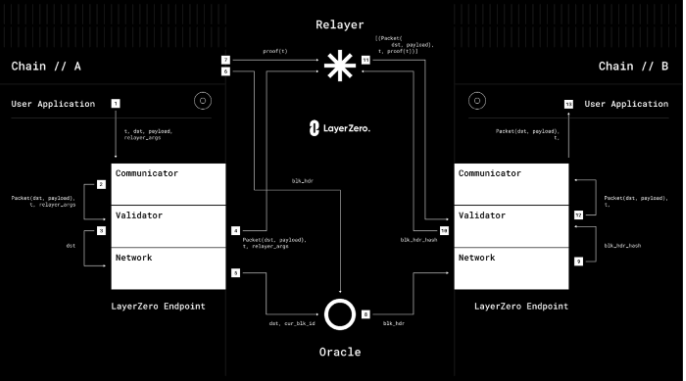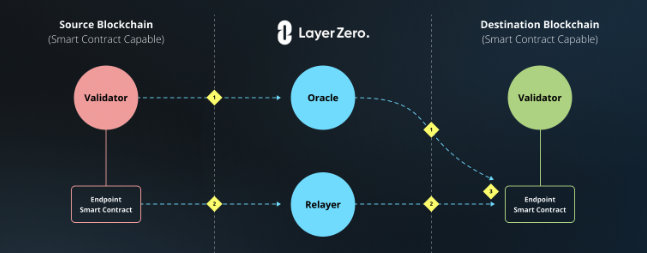
LayerZero serves as an all-encompassing, interoperable protocol with the goal of integrating every smart contract across all blockchain networks. By employing an Ultra Light Client architecture, LayerZero is capable of establishing a universal messaging protocol that spans multiple chains, thereby facilitating more cost-effective validation of Ethereum and other high-throughput blockchains.
Fundamentally, LayerZero functions as a generalized communication protocol, eschewing a narrow focus on cross-chain decentralized exchanges (DEX) in favor of a more expansive vision. Its design as a foundational messaging protocol allows higher-level applications to build on top of it, thereby providing a variety of functionalities. LayerZero's innovative cross-chain communication primitive paves the way for an array of omnichain applications to be developed on its platform. Some potential use cases include:
- Cross-chain decentralized exchanges
- Cross-chain yield aggregators
- Cross-chain lending platforms
It's important to note that LayerZero merely serves as the communication foundation for these applications and operates at different levels within the implementation stack. Its scope extends to support all layers, including direct messaging between
Presently, when a DEX aims to expand its reach to multiple chains, liquidity is fragmented across these networks. Consequently, DEXs, such as , though deployed on 25+ chains, are unable to compete with native DEXs on other chains due to lower volumes and fragmented total value locked (TVL). This fragmentation of liquidity leads to elevated fees, increased slippage, reliance on third parties, and various other challenges for end-users attempting to bridge across chains.
LayerZero addresses these issues by using a fundamental concept known as "valid delivery" to facilitate cross-chain communication. This mechanism allows for cross-chain transfers or arbitrary data exchange by providing two essential guarantees:
- Every message transmitted across the network is accompanied by a transaction on the sender's chain.
- A message is delivered to the recipient if, and only if, the associated transaction is valid and has been committed on the sender-side chain.
To ensure "valid delivery," LayerZero mandates that the involved in the process be independent entities. Additionally, LayerZero has recently integrated Inter-Blockchain Communication (IBC) to offer a robust set of communication and token standards built atop LayerZero's transport layer.
Abandoning the need for a central chain, LayerZero relies on off-chain entities—oracles and relayers—to facilitate message transmission between chains. When a request is received by LayerZero's smart contracts on chain A, the relayer forwards the transaction proof to chain B, while the oracle submits the current header of chain A. Validators on chain B then verify the compatibility of the transaction proof and block header before directing the request to its intended destination on chain B.
LayerZero is the first trustless omnichain interoperability protocol, providing the base infrastructure (blockchain primitive) for low-level communication between blockchain networks. At its core, LayerZero is a messaging protocol that allows for communication between apps across blockchains. It enables dApp developers to turn their once-isolated and fragmented projects into omnichain-applications that can communicate and transact across multiple chains all from one interface.
The project was founded by a core team of three co-founders, one of which is . The protocol itself went live in March 2022, launching on the following blockchains:
- Avalanche
This project attempts to resolve the bottleneck with current bridge technologies, which requires users to trust a third party to bridge funds between networks. This problem has led to the theft of over $2 billion through bridge hacks.
It employs a straightforward concept consisting of one on-chain endpoint smart contract, one on-chain relayer, and one off-chain oracle. The protocol uses Chainlink as an oracle provider while running its relayer as a public good, shifting the task of selecting oracle and relay providers to the applications using it. Currently, Sequoia and Polygon's oracles are used by LayerZero.
Essentially, LayerZero improves upon the middleman of trusted custodians, such as Wormhole and ChainBridge, allowing for trust-minimized communication between apps. This is possible due to omnichain, a new concept of inter-blockchain communication enabling dApps to exist simultaneously across multiple blockchains. Most bridging solutions focus solely on asset transfers between chains, but LayerZero aspires to achieve true composability by serving as a generic cross-chain messaging platform. This means that contracts on one chain can connect with any other contract on a different chain, leading to a wide range of new functionalities (a couple of examples below).
It's important to note that LayerZero itself doesn’t handle any of the creation, burning, or transfer of tokens, but rather simply employs the most efficient communication between different blockchain networks.
Cross-chain DEXs
Unlike existing DEX designs that use wrapped tokens or intermediaries, such as sidechains, a DEX built on LayerZero can be designed in such a way that liquidity pools exist on both chains, allowing users to deposit native assets on one chain and withdraw native assets from another chain. Managing state sharing for protocols that operate across multiple chains, such as DEXs and aggregators, can be challenging as they typically require separate sets of codes for each chain and bridge. However, LayerZero offers a single interface and codebase for all cross-chain protocols, eliminating the need for multiple sets of codes. Additionally, LayerZero enables existing automated market makers (AMMs) to execute cross-chain swaps without having to modify their codebase.
LayerZero's messaging feature can support direct bridges (1:1 pricing), automated market maker (xy = k pricing), and other pricing models, such as those used by Curve DAO
Most yield aggregators currently operate within a single-chain ecosystem, such as Yearn Finance. However, single-chain yield aggregation systems can't take advantage of yield opportunities outside of their ecosystem (hence, the name). A yield aggregator that uses LayerZero for cross-chain transactions would be able to execute strategies that tap into the best opportunities across all ecosystems, increasing access to high-yield opportunities and allowing users to take advantage of market inefficiencies.
Multichain Lending
Currently, it's difficult for users to benefit from opportunities on different blockchain networks where they don't hold their assets. Suppose you have assets on Ethereum and want to take advantage of an opportunity on Polygon. You can either transfer all of your assets to another chain and convert it to the native token ($MATIC in this case), or to lend your assets on Ethereum, borrow the desired asset, and then transfer it to the destination chain. LayerZero introduces a lending protocol, allowing users to keep their assets on Ethereum, lend them out, and then borrow the $MATIC directly on Polygon. This removes the need for any intermediaries, such as cross-chain bridges and swap fees.
Modular Approach (Including Security)
LayerZero is a versatile framework designed to promote generalized interoperability, empowering applications to make trust-based decisions for individual transactions. Its streamlined architecture consists of a single off-chain oracle, an off-chain relayer, and on-chain Endpoint smart contracts. Applications using the framework are responsible for specifying their preferred oracle and relay providers. To facilitate this decision-making process, LayerZero recommends delegating oracle responsibilities to Chainlink and operating its relayer as a public service. At present, Polygon and Sequoia operate the oracle used by LayerZero.
Endpoints facilitate the exchange of arbitrary messages between them, allowing applications to select third-party services for the actual transmission of messages (block headers and transaction proofs) across endpoints. Applications can choose oracle/relay services according to their specific cost and security requirements or configure custom settings within the messaging library employed for sending and receiving verified messages. This design strategy also simplifies the process for LayerZero to introduce new proof validation libraries in the future, potentially enabling applications to use zero-knowledge proofs to enhance security or performance.
 Source: LayerZero
Source: LayerZero
The Endpoint comprises four modules: Communicator, Validator, Network, and Libraries (not shown). The Communicator, Validator, and Network form the Endpoint’s core functionality, while additional chains are incorporated as Libraries. This modular design allows LayerZero to effortlessly integrate new chains without altering the core modules. Each chain within the network possesses its unique Library, and every Endpoint retains a copy of all Libraries, enabling seamless communication between two chains with only their respective libraries on both ends.
For cross-chain transactions, the workflow is as follows:
messages from the sender side are passed down the stack through Communicator -> Validator -> Network, and then up the stack on the recipient side via Network -> Validator -> Communicator.
LayerZero ensures scalability without incurring excessive costs through its Ultra Light Node (ULN) design. It accomplishes this by assigning the task of obtaining cross-chain headers and transaction proofs to off-chain entities, namely, the relayer and oracle.
The oracle streams block headers on-demand, enabling the desired full header sync state more efficiently. The submitted header is cross-verified with the transaction proof provided by the relayer, thus offering the security of a light node while maintaining cost-effectiveness.
Initiating a message transfer request begins with applications sending transactions to a chain's Endpoint. The Endpoint then requests the chosen oracle provider to retrieve the corresponding block header from the source chain and transmit it to the Endpoint on the destination chain.
Simultaneously, the source chain's Endpoint generates a transaction proof, which the relayer conveys to the destination chain's Endpoint. The block header and transaction proof are verified and matched by the destination chain's Endpoint before the message is submitted on-chain. Both the oracle and relayer are compensated per transaction by the requesting user on the source chain.
While LayerZero markets itself as the first "trustless interoperability protocol," this claim is contingent on the assumption that the oracle and relayer don't conspire to compromise the security of the sender's message. An attacker who infiltrates the oracle network could operate their own relayer to undermine safety, meaning that the message sender must trust the oracle provider for security. Although an application could operate its own relayer to ensure proper delivery, this would negate the cost benefits of using a third-party service.
 How messages get sent via LayerZero. Source: Messari
How messages get sent via LayerZero. Source: Messari
Competitive Advantages
Most bridge exploits in the cryptocurrency space from 2020-2023 have been caused by compromised relayers/external validators and liquidity being stored in a single pool. Bridges add trust assumptions and carry additional risks, such as:
- Centralization/Censorship/Custodial Risk Some bridges have a small set of operators that can censor and, in the worst cases, steal user funds.
- Poor Security Practices - Trusted third parties are human and make mistakes. As in the Ronin hack (discussed later), the Sky Mavis team had poor multi-sig security practices, and one individual was the victim of a social engineering hack.
LayerZero looks to address these issues by siloing risk into "application-specific risk," which requires collusion between a specific oracle and relayer for an attack to occur. This means that only protocols using the rogue oracle-relayer pair may be vulnerable, minimizing the damage to specific liquidity pools. However, the overwhelming majority of projects using LayerZero use the default oracle-relayer setup.











